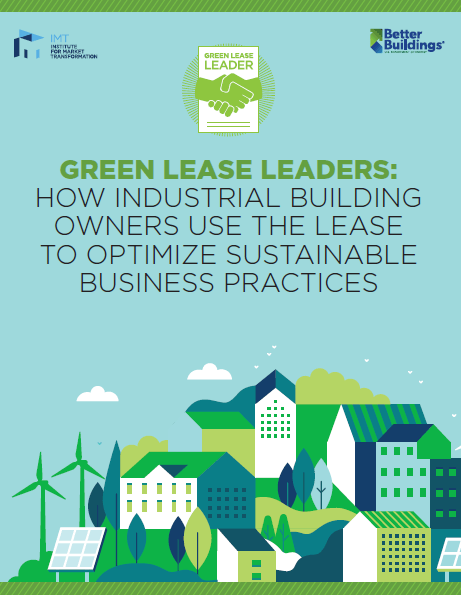The 2019 cohort of Green Lease Leaders span more than 500 million square feet of space and multiple property types, including industrial warehouses and data centers. In many ways, typical lease transactions in these energy-intensive industrial properties create unique hurdles to owners and tenants investing in greater efficiency and sustainability. In this case study series, Green Lease Leaders: How Industrial Buildings Owners Use the Lease to Optimize Sustainable Business Practices, IMT and the U.S. Department of Energy’s (DOE) Better Buildings Alliance highlight Green Lease Leaders Rexford Industrial, Sabey Data Centers, and STAG Industrial for the smart energy strategies each company is deploying in their leasing practices. Their efforts are knocking down pervasive split-incentive barriers and enabling new investments in higher-performing buildings and portfolios that achieve major cost savings, more efficient operations, and easier adoption of renewable energy.
Download the case studies to learn how:
- Rexford Industrial uses green leasing to sharpen its focus on sustainability as a business model for its company while increasing the value of properties and bringing environmental and social benefits to its tenants. Its standard lease and code of conduct help ensure sustainable energy management, including requirements to use programmable thermostats and lighting controls, diligently maintain HVAC systems, restrict janitorial work to tenants’ regular business hours, and submeter units at multi-tenant properties. “Rexford is committed to finding ways to increase our commitment to sustainability in all aspects of our business, and green leasing immediately made sense to us,” said Laura Mask, Vice President and Assistant General Counsel for Rexford Industrial.
- Sabey Data Centers (SDC) ensures its multi-tenant customers, no matter their requirements, can save energy while continuously powering servers and cooling airflow for the optimal performance of complex systems and technologies. “Data centers are infrastructure-intensive and require an immense amount of energy. This means that the great majority of our sustainability programs are focused on how best to use energy more efficiently,” said John Sasser, Sr. Vice President Data Center Operations at SDC. “If we can use a green lease to help us collaborate with our tenants to make strides on efficiency, then we’re all working together to play our part in bettering the environment.”
- STAG Industrial finances efficiency projects at no up-front cost to its tenants, while using its lease to ensure access to energy performance data so it can track and identify future capital improvement projects across its entire portfolio of buildings. “We know the opportunity to lead on sustainability is right now. The work we are doing today is positioning us to be ahead of our competitors and regulations. Adopting green leasing that further advances our sustainability goals is not an overnight process and as an organization, we want to be proactive, thoughtful, and purposeful in the steps we take,” said Brian LaMont, Senior Vice President Capital and Construction Management.
Want to learn more about how Green Lease Leaders are pushing the envelope on energy efficiency in leased properties? Download the new case study, Green Lease Leaders: How Industrial Buildings Owners Use the Lease to Optimize Sustainable Business Practices.
Looking for more green leasing resources and sample language to include in your lease? Visit greenleaseleaders.com/resources.
Become a Green Lease Leader
If you are a tenant encouraging your landlord to collaborate on sustainability goals, or if you’re a landlord working closely with tenants to make their space more efficient and healthy, you might be a candidate for IMT and DOE’s Green Lease Leaders recognition.
A first step is to assess your lease and corporate documentation in comparison to the standards specified by the Green Lease Leaders recognition program. Even if you are not currently including energy efficiency and sustainability in your lease, but practice sustainability in building operations and management, the Green Lease Leaders criteria can serve as a guide for enhancing a lease to account for sustainability.
For more information on Green Lease Leaders, or for help in building your own green lease, visit the Green Lease Leaders website to learn more about the program and how to apply for recognition at greenleaseleaders.com/apply or contact IMT at imtweb@imt.org.
About IMT
The Institute for Market Transformation (IMT) is a national 501(c)(3) nonprofit organization that catalyzes widespread and sustained demand for energy-efficient buildings. Founded in 1996 and based in Washington, D.C., IMT leverages its expertise at the intersection of real estate and public policy to make buildings more productive, affordable, valuable, and resilient.
A trusted, non-partisan leader, IMT focuses on innovative and pragmatic solutions that fuel greater investment in energy-efficient buildings to meet local market priorities. IMT offers hands-on technical assistance and market research, alongside expertise in policy and program development and deployment and promotion of best practices and knowledge exchange. Its efforts lead to important policy outcomes, widespread changes in real estate practices, and lasting market demand for energy efficiency—resulting in greater benefits for all people, the economy, and the environment.
Visit us at www.imt.org and follow us on Twitter @IMT_speaks.
About the Better Buildings Alliance
The Better Buildings Alliance is a U.S. Department of Energy (DOE) effort to promote energy efficiency in U.S. commercial buildings through collaboration with building owners, operators, and managers. Members of the Better Buildings Alliance commit to addressing energy efficiency needs in their buildings by setting energy savings goals, developing innovative energy efficiency resources, and adopting advanced cost-effective technologies and market practices.



